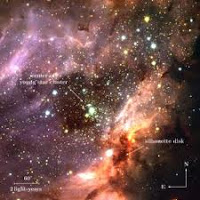Nova - A
star increases its brightness repentivamente and unprecedented ways, giving the
impression that a new star has appeared where before there was
nothing. Hence the name "nova" or again.
Black hole -
An object whose gravity is so strong that not even light can escape
it. Black holes represent the last stage of evolution of massive stars
(from 10 to 15 times the mass of the sun). If a massive star goes
supernova, the remains of the star, after the violent explosion, is a dead star
that has run out of fuel. With no contrarrestren forces to gravity, this
dead star will collapse on itself, to thus become a point of zero volume and
infinite density, creating what is known as a "singularity". As
the density increases, the trajectory of the light rays emitted by the star are
bent until eventually surround the star. Any emitted photon is trapped in
orbit by the intense gravitational field. Because light cannot escape once
the star reaches infinite density, this object is called a black hole.
Redshirt -
This is a shift of spectral lines towards larger wavelengths (or lower
energies), and is the result of the remoteness of the object relative to the
observer. The cosmological redshirt is the result of the expanding
universe and the finite speed of light.
Non-Thermal Emission -
In the thermal emission (black body) there is a clear relationship between the
distribution of energy in wavelength and temperature of the object. By
contrast, non-thermal radiation does not obey the relationship so simple. The
synchrotron radiation in radio waves, emitted by electrons moving at
relativistic velocities by a spiral around magnetic fields, is an example of
non-thermal radiation.
Brown Dwarf - is an object of
low luminosity with a mass that lies between a star and a planet. With a
mass of between 1 and 8% of the Sun, a brown dwarf is too small for it to occur
in thermonuclear fusion, which is what defines a star. Only a theoretical
concept until 1995, hundreds of these objects has been discovered in recent years.
Ultra-luminous infrared galaxy
(ULIRG) - This is ultra luminous infrared galaxies that emit most of their
light in the infrared and have a brightness of over a billion suns. The
high luminosity of ULIRGs is thought to be due to multiple events of star
formation very widespread throughout the galaxy (perhaps caused by a collision
between galaxies), or to an active galactic nucleus in the center of the galaxy.
These objects were discovered by IRAS in 1983.
Radio Galaxy -
A galaxy is extremely bright in radio waves. It is usually a giant
elliptical galaxy intense source of synchrotron radiation.
Seyfert galaxy -
A type of spiral galaxy whose nucleus is very bright and its spectrum shows
broad emission lines.
Gravitational lens - can
be a massive galaxy or galaxy cluster that lies between us and a distant
astronomical object. His presence makes light of the object to deviate
under the gravitational field of the lens. Gravitational lenses can focus,
distort and divide the light beams in the same way that an ordinary lens.
Interstellar Medium
(ISM) - Gas and dust found
between stars of a galaxy.
 Metallicity -
is a measure of the amount of heavy elements (metals) containing the stars and
the interstellar medium? In the astronomical context, a metal atom is any
heavier than helium. Metals are the result of thermonuclear fusion of
hydrogen and helium in stars, and during the later stages of stellar evolution
these metals are ejected into the interstellar medium. The interstellar
medium is therefore continually enriched by heavier elements novae and
supernovae that occur in successive generations of stars.
Metallicity -
is a measure of the amount of heavy elements (metals) containing the stars and
the interstellar medium? In the astronomical context, a metal atom is any
heavier than helium. Metals are the result of thermonuclear fusion of
hydrogen and helium in stars, and during the later stages of stellar evolution
these metals are ejected into the interstellar medium. The interstellar
medium is therefore continually enriched by heavier elements novae and
supernovae that occur in successive generations of stars.Planetary Nebula - A bubble of gas surrounding a hot star dying. The star is so hot it makes the planetary nebula glow, allowing astronomers to see it. The star, who once was the core of a red giant, its outer atmosphere expelled creating a planetary nebula, which incidentally has nothing to do with planets, but through a small telescope its presence seems to remember the disk of a planet, and hence the misnomer.
Active Galactic
Nuclei (AGN) - Active galactic nuclei (AGN) are the center of some
galaxies where black holes are thought responsible for its
luminosity. These nuclei produce enormous amounts of energy, exceeding the
light emitted by all stars in the galaxy. A quasar is a specific type of
AGN.
Quasar -
Also known as quasi-stellar object (QSO). This is a star like object that
has a large red shift and is a very strong source of radio waves. Most
likely this is an extragalactic object (external to our Galaxy) highly
luminous.
HII region -
Nebula containing gaseous material to a temperature of about 10,000 degrees
Kelvin. At this temperature the hydrogen is ionized and electrons move
freely.
Super-Planet -
A planet with a mass similar to Jupiter or larger. Jupiter is about 318
times more massive than Earth.
Astronomical Unit
(AU) - The average distance between the Sun and Earth. 1 AU is
149,597,870.691 km (about 93 million miles). The Astronomical Unit is a
constant that is used to measure distances within our solar system.
Young Universe -
The Universe Young refers to approximately the first billion years after the
Big Bang (Big Bang), estimated occurred about 14 billion years. Due to the
expansion of the universe, this corresponds to the most distant reaches of the
universe.



















No comments:
Post a Comment